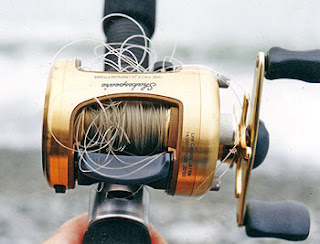Have you ever gone fishing with new line on your reel and had the line have
loops and twists? Well let me shed some light on how to put line on a fishing
reel without having it twist like Chubby Checker or have a birds nest that would
make big bird jealous. The open faced reel can be the king of twists and loops,
while the bait casting reel can generate some of the biggest bird nests.
Let us start with why this happens to the open faced reel. When the line
goes on the reel you must keep consistent pressure on the incoming line,
if you do not you will have loops. The twists in your line come from putting the
line on with the two spools in positioned in opposite direction (installing line
to an open faced reel should never done by sticking a pencil through the center
hole and allowed to spin like a wheel). You must have the spool of the
reel as well as the new line positioned in the same direction. If not you will
spend the day fighting your line and no a fish.
Installing line to an open faced reel - feed the line through all of
the eyelets (starting with the rod tip to the reel) on my rod, tie a loop in the
line about the size of a dime. Then poke a bit of the line through the loop to
create a noose. Now put the line under the bail, then slip the noose over the
spool. Place the new line spoon on the floor in front of you so the line
will be pulled off the side of the spool (the line and reel are now a
lined). Have a seat, now place the butt of the rod between our legs (rod
holder), you will need one hand to reel the reel and the other for applying the
consistent pressure to the line.
Place the other hand near the eyelet closest to the reel you will want to
hold the rod as well as the line. Slowly reel the line from new line spool into
the eyelets of the rod then into your hand that is holding the rod and line like
you would a baseball bat. Slow consistent pressure is what you need here. Going
fast will put loops in your line and you will not know it until you have cast
ten or so times.
The loop is generated when you have loose line in your reel. As you make a
cast and then retrieve the line into the reel while fishing , the line goes on
the reel’s spool much tighter than the line that is underneath thus creating a
loop.
If the loop is not pulled out you will most likely have a monofilament mess
and of course it will happen at the least opportunistic time.
While installing line to an open face reel has its challenges the bait
caster has a few of its own.
Installing line to a bait casting reel- first feed the line thought the
rods eyelets as you did with the open faced reel and when you have fed the
line to the reel just tie the line to the reel‘s spool and trim the excess line.
The consistent pressure to the line is administered the same way as well.
The big difference is the way the new line spoon is held.
You will need a pencil and bare feet. Put the pencil thought the center
hole of the spool like a bike wheel, now hold the pencil with the spoon with
your toes. Put the butt of the rod between your legs (rod holder), now with one
hand wind the reel while the other hand will hold the line and rod (pressure to
line). Your feet will be holding the pencil with the spool.
When putting line on a reel make sure both spools are facing the same way
this minimizes twists while you have consistent pressure on the line it self
this will reduce twist in your line. By all means go slow. Installing new line
on a reel may seem easy, but if done wrong it could cost you fishing time, money
or possibly a fish of a life time.
We have all heard the line “it’s only as strong as its weakest link.” When
putting the statement into the contexts of your rod, reel and line, well it is
safe to say that the weakest link is the line. If a fisherman takes good care of
his or her line (not leaving it to the elements, mainly the sun) one could
expect to fish an entire season with the same line. I’m not one of those people
so I’m forced to change my line once in the spring and then again in the fall. I
have also found that the poundage of the test does not matter as to the
frequency of changing. The bottom line on line is take care of it and it will
take care of you.



No comments:
Post a Comment
Please let me know what's on your mind....